Have Dodge, Will Travco: How One Man’s Camper Ushered “Motorhome” into the Lexicon
Brown City, Michigan is about 60 miles northwest of Detroit. The rural town of about 1300 people feels pretty far removed from the Motor City. Like much of Michigan’s “thumb,” this town’s roots are more agrarian than automotive. Yet, as the welcome signs proclaim and the city’s official insignia remind you, Brown City calls itself the “Birthplace of the Motorhome.” If nothing else, it’s certainly responsible for the genesis of that term—all thanks to what became known as the Dodge Travco Motorhome.
Quite a lot of Travco history has been lost to time, but all accounts suggest the story began in Brown City in 1958, when local farmer/ part-time trailer manufacturer Ray Frank felt the itch to design and build a rolling home-away-from-home for family vacations. The result—a fairly ungainly-looking, aluminum-clad conveyance—used Dodge powertrain and, depending on the tale you choose to believe, was constructed inside a chicken barn.
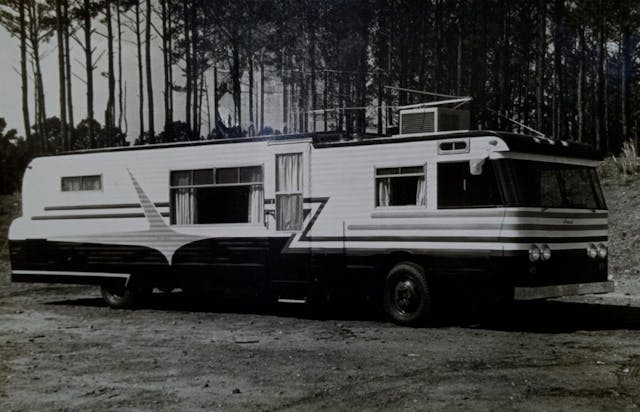
Frank’s creation wasn’t the first RV—plenty of “camping cars” and “house cars” preceded it in the decades prior—but it was the first to be christened with the name “motor home,” a term Frank coined after first trying the less-convincing “motorized trailer.” Frank ultimately hand-built several one-off copies for well-heeled travelers. No two examples were completely alike; in fact, a price list from 1960 suggests both front- and rear-engine designs were offered; Dodge engines and stratospheric price tags ($9000-$11,000, or $95,000-$116,000 today) were the only shared characteristics.
By 1961, Frank decided there was enough demand to build RVs full-time and sought a standardized chassis from which to work. Apparently a Mopar loyalist, Frank turned to Chrysler, but he didn’t quite find the chassis he required. Sure, Dodge built stripped chassis for step vans and milk trucks, but those were based on light-duty pickups and, at the time, equipped only with six-cylinder powerplants. After some coaxing, Chrysler managed to cough up a modified version of its sturdiest P300 chassis, now fitted with the A-series polyspherical-head 318 V-8 and a Torqueflite transmission. From there Frank was off to the races, building 20, 23, and 26-foot long motorhomes.
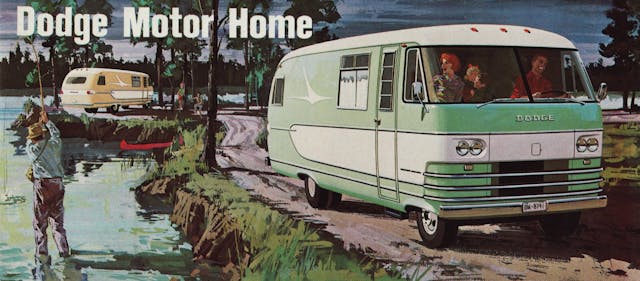
A complete upheaval of the Dodge Motor Home lineup arrived in 1963, doing away with the the varying lengths and boxy aluminum bodywork. Frank switched to a single 27-foot model, wearing a body molded from fiberglass and draped across tubular steel supports. If Frank wasn’t the pioneer of this construction method, as his entry at the R/V Hall of Fame suggests, he was certainly one of the first RV manufacturers to use it. If nothing else, the new body’s appearance was unique; his 18-year-old son allegedly helped Frank design a rotund body with a tapered tail and minimal wheel openings.
So, exactly how involved was Chrysler in this venture? To this day, it remains unclear. Some suggest Chrysler offered fiscal and engineering support to Frank and his team, pointing to that modified P300 chassis (aka the P375) as a sign of corporate patronage. Others remember that Chrysler originally declined to build and sell Frank the chassis he was looking for, forcing him to partner with a local Dodge dealer to source his chassis. That was all before Chrysler had a change of heart and ultimately developed its own line of motorhome-specific chassis.
This much is certain: Frank’s motorhome had the Mopar marketing machine on its side. Not only did Frank freely market his creation as a “Dodge Motor Home” starting in 1961, but Chrysler itself pitched the campers through its own PR office and ad agencies. By the mid-1960s, the Motor Home was a familiar sight in Dodge’s own truck sales literature and at select Dodge dealerships. Later Motor Home literature even used a logo suspiciously similar to Dodge’s own trademark. Yet despite this cozy relationship, Motor Home literature made clear these coaches were the product of an “authorized body builder.”
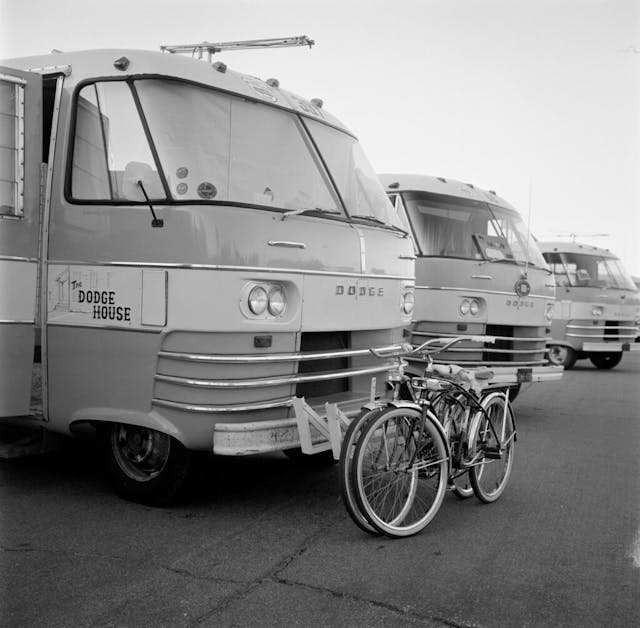
Frank sold the motorhome business in 1965 to PRF Industries, which owned several other RV manufacturing entities, including one that would go on to furnish interiors for the GMC Motorhome. PRF then formed a new subsidiary—Travco—to oversee the Brown City operations, which carried on molding giant slabs of fiberglass and assembling Motor Homes with little change.
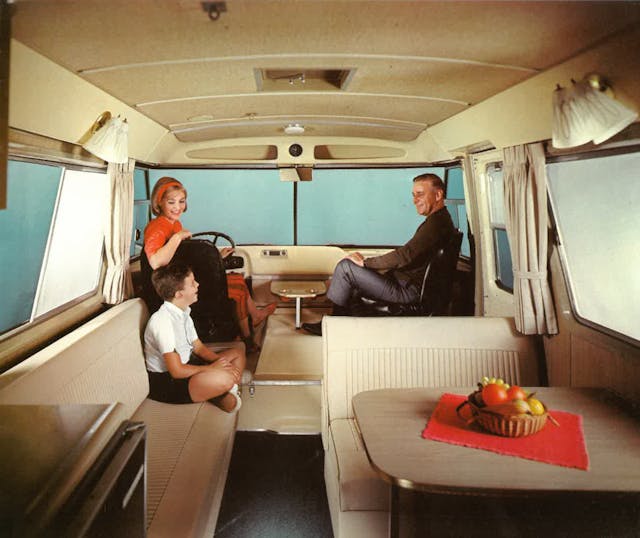
Both Frank- and Travco-built motorhomes earned a reputation for being stout, well-made machines. All the conveniences of home—including integrated air conditioning, TVs, and hi-fi stereos—were available at added cost, if so desired. In its 1968 buyer’s guide issue, MotorHome Life Magazine called the Dodge Motor Home “a high-cost super-deluxe unit, lavish and top-quality in every respect, from basic engineering through interior decor.”
A later “Dodge Mahal” model further leaned into this luxurious reputation, fitting niceties like a credenza with folding table, plush carpeting, velour drapes, and a heated towel drying rack at the angled galley-style kitchen.
As these Motor Homes traveled the world, they managed to worm their way into pop culture. An early Frank-built example gained prominent placement on an episode of The Donna Reed Show while CBS News correspondent Charles Kuralt kicked off his decades-long On The Road travel series in a Dodge. Traveling country musicians seemed to hold these models in high esteem; “Doc” Tommy Scott was an early adopter, while Johnny Cash’s red-and-white example had a cameo in a 1969 documentary film about the singer.
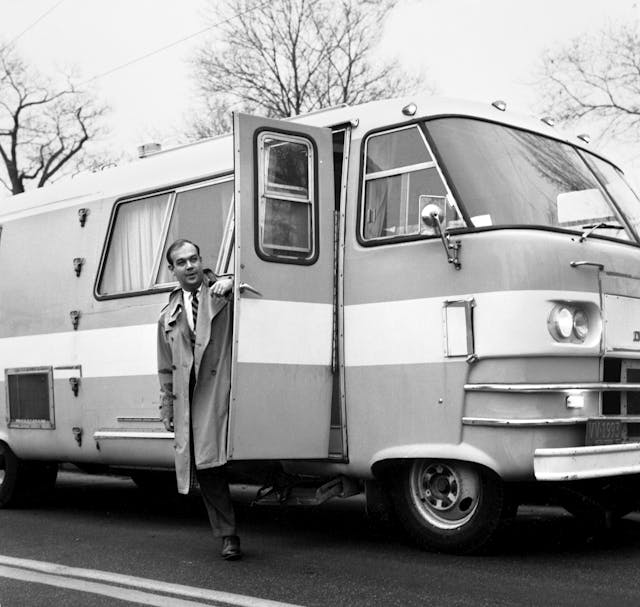
Like many other motorhomes, Travcos were also sold as “Commercial Travellers,”—empty shells that allowed businesses to upfit the vehicle for use as a mobile office, banking center, TV repair shop, or, as in the case of two enterprising Vermonters, a mobile ice cream parlor.

Travcos also found their way into the world of motorsports. A rented 1966 example competed in the inaugural public running of the Cannonball Baker Sea-to-Shining-Sea Memorial Trophy Dash, finishing dead last after driving 57 hours coast-to-coast (and ruining a freshly baked lasagna in the process). Across the pond, a Travco decked out in John Player Special colors served as a trackside shelter for Team Lotus drivers during the 1973 Formula 1 season.
So why is “motorhome” a household name when Travco isn’t? Blame stiff competition, especially in the late 1960s and early 1970s, which chipped away at Travco’s market share with more affordable options. A 1966 price list for Travco motorhomes notes a 27-foot model stickered at $11,995 before options—almost half the median price of an actual house that year. Meanwhile, Winnebago Industries was happy to sell you a new motorhome; it was shorter and less fanciful, certainly, but a motorhome nonetheless and for half the Travco’s asking price.
PRF tried to adapt. It added new model lengths and floorplans and applied the occasional styling facelift using newer Dodge chassis models with updated engine choices (the A-series 318 gave way to the 413 and, ultimately, the 440). It even went so far as to launch a less expensive (and completely different-looking) Travco-branded model in the early 1970s.

In the end, Chrysler wound up pulling the rug out from beneath the company. Looking to shed any non-core businesses as it teetered on the verge of insolvency, it exited the North American medium-duty truck and motorhome chassis markets in 1978. Travco, which remained exclusive to Dodge all this time, suddenly found itself up a creek without a chassis, unlike many of its rivals, which had already built GM-and Ford-based motorhomes for some time.
The following year, PRF sold Travco to rival Foretravel, which continued building Travco-based motorhomes—including rear-engined pusher models and a 35’ three-axle coach—into the late 1980s. After that, Foretravel focused on its own designs.
The Frank/ Travco/ Dodge Motorhome may not be as technically innovative as GMC’s all-in-house creation, nor has it inspired a cult-like following to rival that of Airstream. There is, however, a small group of loyal owners—many of whom congregate within a Facebook group chock full of historic and helpful information—who endure. These Travco die-hards find the Dodge Motor Homes endearing enough to own and, most importantly, drive.
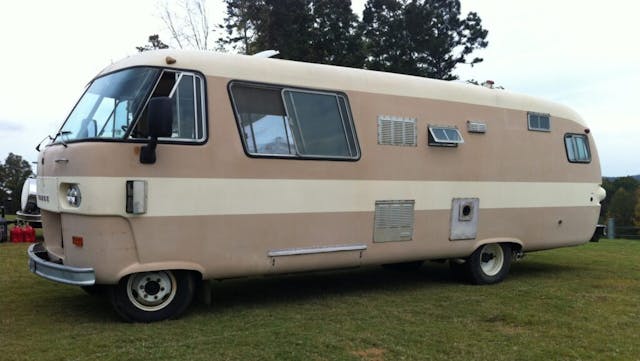
Among their ranks, we find Hagerty reader Chase Fell of Birmingham, Alabama. While his brother originally fell in love with Travcos and discovered this particular 1966 270 model sitting in a Texas field in the late 1980s, the motorhome managed to charm Fell into bringing home the remarkably original coach in 1999.
“I’ve messed around with old cars and trucks for a while, but this is just something different,” Fell says. “Almost no one seems to have one in these parts, and certainly not at the car shows I take it to. So many Travcos suffer from ‘strip and run’ syndrome—someone has the romanticized idea of restoring one before realizing they’re restoring both a house and a car at the same time, and find themselves underwater.”
While some owners continue to use their vintage Travcos for traveling, Fell isn’t one of them. Instead, his fiberglass-bodied Mopar serves as an interesting cruiser.
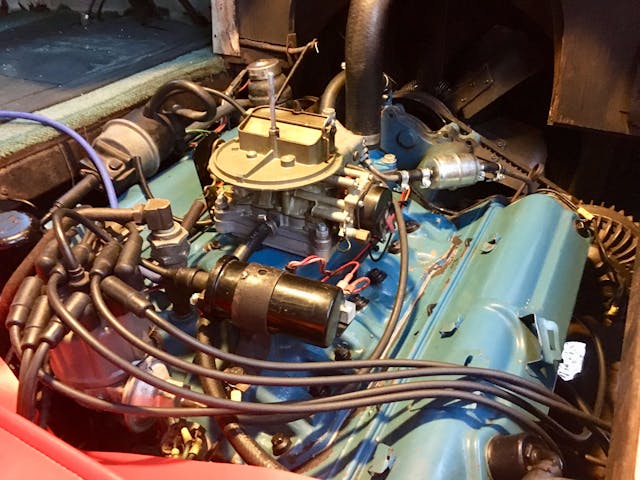
“I love tinkering on it, even if I find myself repairing repairs I made 20 years ago,” Fell says, noting it helps that the kitchen cabinetry effectively serves as an in-house tool chest. “But I really just like taking it out for a drive. It doesn’t fit in my neighborhood, so even just the act of going out to take it for a spin is a day trip in itself.
“But I still love the thrill of firing it up and getting a 58-year-old RV from point A to point B without failure, even if it’s just across town. That’s enough fun for me.”
***
Check out the Hagerty Media homepage so you don’t miss a single story, or better yet, bookmark it. To get our best stories delivered right to your inbox, subscribe to our newsletters.



Still not as good as the Condor II that Cousin Eddie drove.
It’s a pretty cool thing. I would not want to drive it on a windy day across the Mackinac Bridge.
I saw an article in an older (maybe the 50’s) Popular Science magazine that showed how someone built a motorhome of sorts out of a Jeep. It was boxy with flat glass windshield and a lawn chair for the driver, who was smoking a pipe. I’ve driven some questionable vehicles, but this was the most dangerous as-designed thing that I have ever seen.
My dad bought a new 27′ in 1968, let and three buddies take it to Mustang Island Tx for spring break with my Myers Manx in tow, what a great trip. Not sure how many dads today would would let four 18 year old kids take his new high end RV on a trip like that today, thanks Dad RIP.
House-on-wheels fans, does anyone remember the late ’80s ‘BMW’ Vixen? BMW didn’t actually make it- they were built in Pontiac, MI. You cannot say ‘what were they thinking?’ without mentioning the Vixen with 115 bhp turbodiesel straight 6 powering a 5200-lb lump with a Renault transaxle. One of the guys in my car club owned one (with a BMW logo up front which p-od local bimmer fans) that faithfully broke something about once a week. We called it the ‘Victim’. In 5 years I only saw it in motion once.
Yes, met an owner on the road years ago. Got a chance to walk through, loved it. Nice little pusher unit that was very well thought out. With the popup roof I could stand up (6’1″) and yet it was low enough to fit under a 7 ft garage door. Aerodynamic enough to get more than double the mileage the Southwind MH we had at the time.
I worked at Chrysler’s Warren Truck Assembly Plant the summer of 1978 as a college student. Chrysler made these chassis at a small sub-plant we referred to as “Sherwood,” at the corner of 9 Mile and Sherwood. I remember my crew spending a few weeks there that summer cleaning the plant out, which IIRC had already been shut down.
I recall a local mfg that built custom units, on the GM chassis. The chassis were built as fully functional “vehicles” when delivered. It was a hoot to see the transport guy, sitting on a wooden crate of assumed accessories, actually driving the chassis off of a carrier and into the lot. A neighbor had a Dodge, never realized how expensive those were.
My father was one of five employees that managed the company for Peter Fink (PRF) since 1962 or 1963. In their first meeting with Mr. Fink, they were tasked with naming the company. They came up with Travel Company, which Pete shortened to Travco. Most of the article was very accurate. I have an hour long video with my father discussing the success and demise of the company before he died at 90. Many celebrities owned units in the 60’s and 70’s. They loved coming to Brown City because they were left alone and just treated as people.
I have fond memories of these. My Dad had one in the late 60s. I think it was a 65, it was red with the white band. It rolled on 16″ (16 ½?) wheels, and it had Michelin tires without the proper load rating. The result was that Dad (and I when with him) got proficient in changing a wheel on the side of the road. Occasionally Dad’s parents would come along, and we’d play cards on the dining table while Dad was driving. Dad would drive at night and draw a curtain closed behind the driver and passenger seat. My sister and I slept on the couch, she on the bottom. The back swung out from the bottom and had straps that looked like seat belt material that clipped to an eye in the ceiling. Dad & Mom were amazed I never fell off of it. I hooked my arm around one of the belts, and never did fall out. Great memories, thanks!
Good memories!